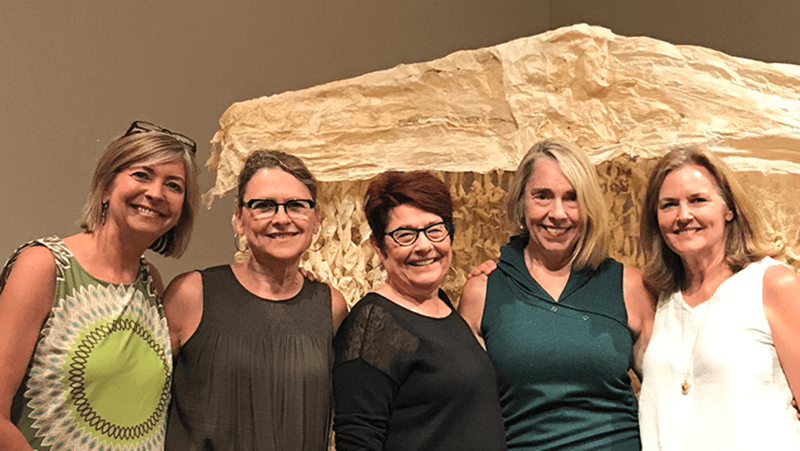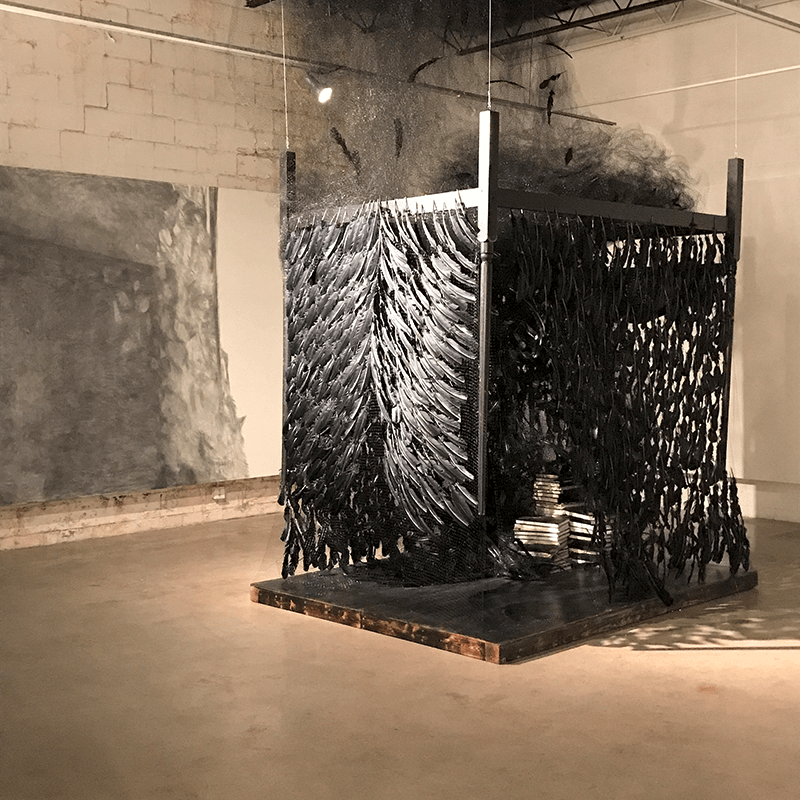Group critique, sharing helps artists grow
by Susan Wagner
Several years ago, when still relatively new to the Northeast arts community, I was asked to join a small group of practicing artists for critique, knowledge sharing and I didn’t know what else, but I was eager to be part of it. It was good timing. I was looking for a deeper connection to the arts community in Northeast to share my work and ideas and to get feedback in a supportive and encouraging environment.
It has become one the most valued components of my art practice life. Our group of painters, collagists, and fiber artists includes myself, Mary Simon-Casati, Suzanne Skon, Carmen Gutierrez-Bolger, and Carolyn Halliday.
We meet every couple of months to serve each other as another set of eyes to help guide focus or constructively critique our very individual paths. Our way of creative exchange has taken time to develop. In our group, it’s important that we can talk about all aspects of the creative life. For the most part, we make our art in solitude so having a trusted group of colleagues to touch base with has been a lifeline.
Coming together to discuss work and challenges is invigorating and inspiring, helping to keep momentum high and, as Carolyn states, it all “boils down to the almighty sense of inspiration and enthusiasm to go make more work.” As Mary says, we’re “able to share with knowledgeable and trusted colleagues who experience similar things. We can talk through strategies to solve artistic problems.”
That we make very different art has been a benefit to each of us in how we critique and look at our groups’ art, and other artists. A painter looking at fiber art is going to have a different take on things and as Suzanne says, “I like scheduling field trips to galleries and museums with our group because it is just a joy to discuss art when we each bring our own subjectivity to the experience.”
It matters to us that we are part of a larger community of artists, whether in NE or St. Paul. Most of us have our studios in NE, (Casket Arts, Solar Arts) with Carolyn having moved to a studio in the Triangle Building on University Ave in St. Paul. There’s a shared-activity energy in the air that hums around us and helps feed the energy to make the work. Carmen says, “I like to think that working in NE Minneapolis, this very vibrant, multi-generational, multi-discipline community makes my art more “important” somehow…I very much believe that we all feed on the energy that we put out.”
As a group we try to keep refining how best to use our time and give the most effective criticism and support. It’s an ongoing process of development, as is our work.
—Susan Wagner makes oil and mixed media paintings based on the architecture of the landscape and other natural forms.
Not sure what installation art is? Don’t worry, you aren’t alone.
by Sarah Ratermann Beahan
The definition of installation art is a moving target. The term is typically used to describe large scale, mixed media art that is often site-specific and designed to have a relationship with the environment in which it’s placed. This type of art and those who create it have found a niche in the Northeast Arts District community.
Artist Rebecca Krinke describes installation art as “an immersive experience.” Krinke, a member of the collective art gallery Rosalux Gallery, was most recently the Artist-in-Residence at the Weisman Art Museum. Her work is intended to be interactive.
“I wanted people to touch, read, contribute writing. The body can be more engaged, and [the art] becomes immediate and alive,” she explains.
Installation artist Jack Pavlik says the term is often used for artists that are “less than traditional.” While Pavlik doesn’t see a lot of installation art exhibited in Northeast Minneapolis, this may in part be due the form’s dependence on the space it requires. “It can be restrictive,” Pavlik says.
Because installation art is often uniquely designed for the space where it is exhibited, it is not replicable elsewhere. Like performance art, the magic of installation artwork is this impermanence. Viewers are engaging with a piece of art that is by nature unique in the space and time in which it exists.
“This work is not collectible. You can’t buy this, it can’t be replicated,” says Krinke.
Barbara Bridges, an artist and former professor at Bemidji State University, creates social practice art using eco-rescued power objects to create art installations. She intends to provoke conversation about a variety of social issues with her installation pieces, including agricultural/food industry practices (Ode to Gluten) and water quality (Found in Our Water), among others.
“I’d already made art to sell,” Bridges says. “I wanted to focus on art that would bring viewers in, that would not normally engage in art.”
In Bridges view, installation art isn’t simply about the artist and the viewer, but it is about the wider community. By creating art that intends to spark conversation, she is drawing the attention of all community stakeholders, not just those who are artistically minded.
Northeast Minneapolis Arts District is a perfect incubator for artists conceiving of this type of work. The prevalence of artists in the Northeast Minneapolis social milieu and in deliberate contact with each other nurtures and promotes innovative art.
“This used to be fringe,” Bridges claims. “But it’s getting more respect. People see the power of it.”
You can see more of Rebecca Krinke, Jack Pavlik and Barbara Bridges’ work, including where they are showing now and in the future on their websites: rebeccakrinke.com, mnartists.org/jack-pavlik, bridgescreate.com.
Below: Photos courtesy of the artists.

